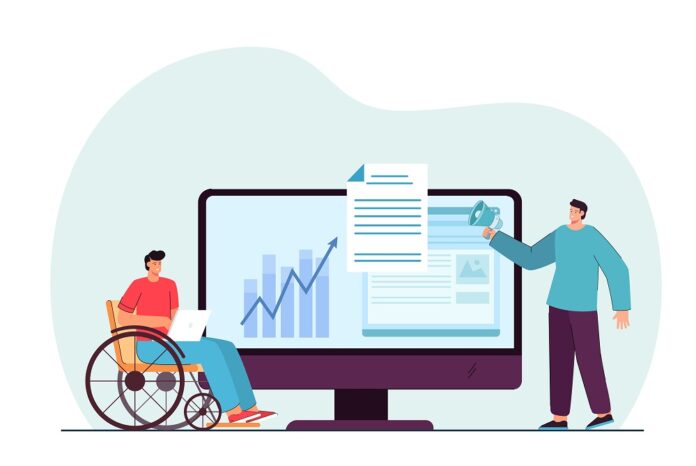The possibility of online accessibility has emerged as a significant issue in a time where the web has saturated each part of our daily existences. The computerized world has developed into a comprehensive stage that acknowledges various individuals with various abilities, as opposed to being the restrictive property of a little gathering. The imperative of Web Accessibility has gained unparalleled significance in today’s generation, shaping not only the online experience but also the values of equality and inclusivity we uphold as a society. Web accessibility is crucial in a world that is becoming more and more digital. It goes beyond simply building an inclusive internet to acknowledge everyone’s right to access information and services online, regardless of skills or limitations. This article examines the importance of online accessibility and provides advice on how to make sure that accessibility guidelines are being followed.
The Foundation of Equality
The principle that everyone should have equal access to information and services, regardless of their physical or mental capabilities, is the cornerstone of online accessibility. People with disabilities may now connect with the digital world in previously unimaginable ways because to technological breakthroughs. This inclusive strategy is in keeping with the core values of modern society since it underlines that everyone deserves an equal opportunity to interact with online content, develop informed views, and engage in a range of online activities. The same equity standards that apply to real-world accessibility also apply to web accessibility. It guarantees people with disabilities equitable access to internet information, services, and opportunities. Web accessibility assures that users with visual, auditory, motor, or cognitive disabilities may browse, engage with, and benefit from digital material without prejudice.
Changing Demographics and Evolving Needs
Today’s generation encompasses a diverse spectrum of abilities, from visual and auditory impairments to cognitive challenges. An aging population is also contributing to the growing significance of web accessibility. As the global demographic landscape shifts, the need to cater to older adults, who may experience diminishing sensory and cognitive capacities, becomes even more pronounced. A digital environment that considers these evolving needs demonstrates a commitment to embracing diversity and ensuring that digital experiences are available to everyone.
Legal and moral obligations
The necessity of online accessibility is being reinforced by legal frameworks in addition to moral and social commitments. Many nations have passed legislation requiring that websites and digital services be accessible to people with impairments, such as the Americans with impairments Act (ADA) in the United States and the European Accessibility Act. Legal repercussions for non-compliance emphasise how vital it is for companies and organisations to give accessibility first priority in their online presence. Upholding these legal standards not only avoids legal ramifications but also fosters a reputation of inclusivity and responsibility. The concepts of equality, legal compliance, and ethical responsibility come together to produce a strong push for online accessibility in the changing environment of the internet. It is an ethical duty that supports the dignity and inclusion of the online experience to make sure that digital material is accessible to people with impairments. This essay explores the critical contributions that ethical principles and statutory requirements have made to the development of web accessibility.
Business and Innovation
Web accessibility is a driver for innovation as well as a compliance measure. Accessibility-focused websites are inherently more user-friendly and adaptable across a variety of platforms and devices. Not simply those with disabilities benefit from this strategy’s better user experience. A further benefit of accessible design is that it motivates developers to go outside the box and come up with fresh methods to engage people and convey material. Innovation in accessibility can result in advancements that help users with disabilities and users without disabilities as the digital environment changes.
Enhancing User Experience
The user experience lies at the heart of web accessibility. An accessible website is easier to navigate, read, and understand, regardless of a user’s abilities. This translates to quicker and more efficient interactions, which can directly impact user satisfaction and engagement. When users encounter barriers such as poorly structured content, lack of alternative text for images, or non-intuitive navigation, they are more likely to abandon the site in frustration. Prioritizing accessibility not only retains users but also expands the potential audience, including those who might have otherwise been excluded.
Inclusive Design: The cornerstone of inclusive design is web accessibility. Designers build user interfaces that are intuitive, adaptive, and friendly to all users by taking into account their different demands.
User-Centric Approach: Giving users top priority naturally places them at the centre of design choices. Through this method, interfaces may be created that are not only useful but also appealing to the eye and simple to use.
Reaching a wider audience: An accessible website reaches out to people with disabilities, increasing its user base and encouraging a more diverse online community.
Positive Reputation: A dedication to online accessibility presents a company as socially conscious and committed to offering outstanding user experiences for everyone.
SEO and Reach
Search engine algorithms are changing to favour accessible websites. Web accessibility is strongly related to characteristics like website load speed, mobile responsiveness, and user experience that are taken into account by search engine optimisation (SEO). Websites may improve their SEO ranking and become more visible to more people by following accessibility requirements. This not only benefits businesses but also contributes to the dissemination of valuable information to a broader range of users.
Social Responsibility and Brand Reputation
In an era where conscious consumerism is on the rise, individuals are drawn to brands that align with their values. Embracing web accessibility showcases a commitment to inclusivity and social responsibility, resonating positively with consumers. Brands that prioritize accessibility send a clear message that they value all customers, regardless of their abilities. Such initiatives can foster customer loyalty, brand trust, and a positive reputation in the market.
The Road Ahead
Web accessibility is not a static concept; it’s a journey of continuous improvement. The techniques and resources available to improve accessibility also advance along with technology. The current standards and best practises must be kept in mind by designers, developers, and content producers. For the development of an online environment that really meets the demands of all users, cross-disciplinary collaboration is crucial.
The conclusion
In conclusion, online accessibility has become a crucial issue in the current digital environment. Its importance derives from the egalitarian, inclusive, and socially responsible principles that guide contemporary society. We can all work together to create a digital environment that represents our dedication to justice, creativity, and compassion by taking into account the various capacities of users, prioritising accessibility, and upholding legal and ethical requirements. By doing this, we not only improve everyone’s online experience but also advance a more welcoming and peaceful international community.
Author bio:
Prashant Pujara is the CEO of MultiQoS Technologies, a custom web development company in USA. With an extensive career of over 10+ years in software development, he boasts formidable proficiency in creating digital applications. His dedication to driving comprehensive digital transformation across diverse platforms, encompassing software and cloud solutions, has significantly defined his illustrious career.








